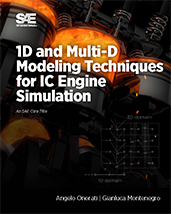Journal Article
A Scale Adaptive Filtering Technique for Turbulence Modeling of Unsteady Flows in IC Engines
2015-04-14
2015-01-0395
Swirling flows are very dominant in applied technical problems, especially in IC engines, and their prediction requires rather sophisticated modeling. An adaptive low-pass filtering procedure for the modeled turbulent length and time scales is derived and applied to Menter' original k - ω SST turbulence model. The modeled length and time scales are compared to what can potentially be resolved by the computational grid and time step. If the modeled scales are larger than the resolvable scales, the resolvable scales will replace the modeled scales in the formulation of the eddy viscosity; therefore, the filtering technique helps the turbulence model to adapt in accordance with the mesh resolution and the scales to capture.

